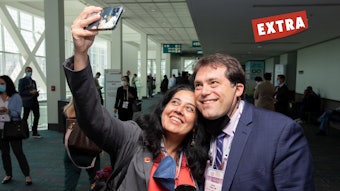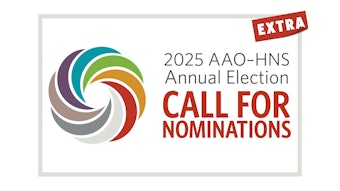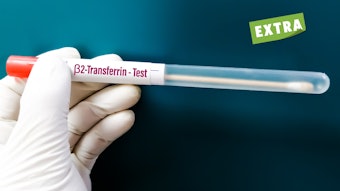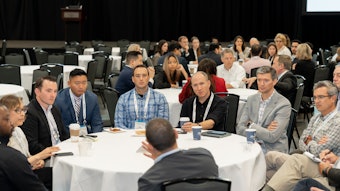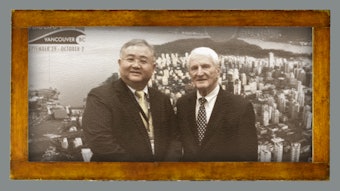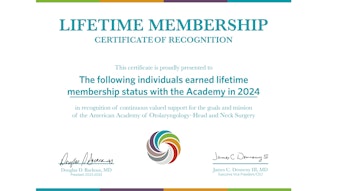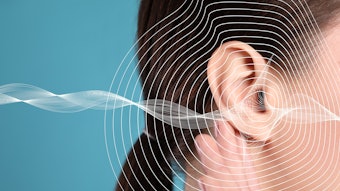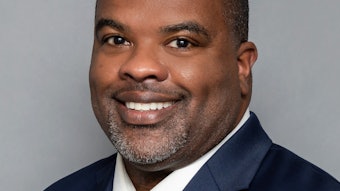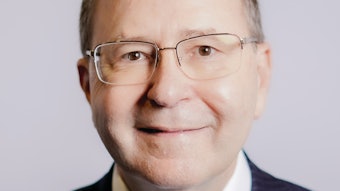Pearls from Your Peers: Adult Unilateral Hearing Loss and Single-Sided Deafness
Tirth R. Patel, MD, interviews Renee Banakis Hartl, MD, AuD, about adult unilateral hearing loss treatments and how to counsel patients.
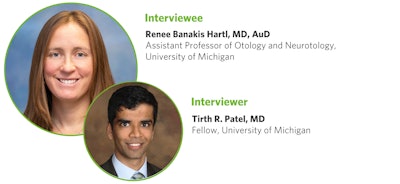
What treatments do you offer adults with single-sided deafness (SSD) in your practice?
There are several factors we consider when offering hearing loss treatment. But for those individuals who have hearing loss in one ear where either the severity of the sensitivity loss or poor discrimination ability precludes the use of traditional amplification, we historically relied on devices that do not rehabilitate the impaired ear directly but rather position a microphone near the affected ear and send acoustic information to the normally hearing (or better hearing) ear. This approach is known as contralateral routing of signal (CROS), and it can be considered in both surgical and non-surgical management (Figure 1). In the most familiar application, CROS hearing aids, the microphone from a hearing aid worn on the hearing-impaired ear picks up acoustic information and sends it wirelessly to the receiver of a device worn in the normally hearing ear. For individuals with some hearing loss in their better hearing ear, a BiCROS system can provide amplification to accommodate for loss of auditory sensitivity (Figure 1). A third amplification configuration, known as ampCROS or triCROS, can be used for those with some residual hearing in the poorer ear. The acoustic signal is routed from the poorer ear to both ears, which can provide tinnitus suppression and potentially some binaural cues, for the appropriately selected patient.1
 Figure 1. Contralateral routing of signal (CROS) and ampCROS amplification configurations for unilateral or asymmetrical hearing loss.
Figure 1. Contralateral routing of signal (CROS) and ampCROS amplification configurations for unilateral or asymmetrical hearing loss.
The same rehabilitative principle applies to bone conduction implants, which are placed near the impaired ear and rely upon bone conduction to transmit sound from the hearing impaired to the normally hearing ear (Figure 2). Like a BiCROS system, these devices can provide some gain for individuals with sensorineural hearing impairment in the better hearing ear, however, these devices generally cannot accommodate more than moderate loss. The mechanical transducers in bone conduction devices need to vibrate the skull with sufficient force to stimulate the contralateral cochlea. Both the frequency response of the transducers (how much gain they can provide at a given pitch) and individual patients’ transcranial attenuation (the loss of energy that occurs with transmission of vibrations across the skull) limit which individuals can benefit. Because of these limitations, non-implantable bone conduction devices are typically not recommended for SSD.
The newest treatment option for individuals with SSD provides rehabilitation to the hearing-impaired ear. The only device in this category is a cochlear implant. For many years, we believed that individuals with normally hearing in one ear would reject cochlear implantation because of the challenge of integrating acoustic stimulation in one ear and electrical stimulation in another, but since the FDA approved cochlear implants for SSD in 20191, it has become an increasingly popular treatment. Systematic reviews and meta-analyses demonstrate consistently high satisfaction with tinnitus suppression2 and show promising improvements in localization and speech understanding in noise3-5, both auditory tasks that require two ears.
 Figure 2. Comparison of CROS amplification versus bone conduction and cochlear implants.
Figure 2. Comparison of CROS amplification versus bone conduction and cochlear implants.
How do you counsel patients who may want a cochlear implant to treat their SSD? Is this different compared to traditional cochlear implant candidates with bilateral hearing loss?
I am very cautious in my counseling approach. Many of our patients with SSD are eager to “restore” their hearing and have high expectations regarding the implant performance. We work closely with our audiology colleagues to educate patients about the difference between acoustic and electric hearing and explain that integration of these signals in the brain takes time and effort, and there are ultimately some limitations to what we they may be able to achieve with this mixed modality treatment option.
For any SSD rehabilitative option, it is important to stress consistent device use and active participation in auditory rehabilitation programs, if available. Compared with implant recipients with bilateral hearing loss, SSD patients are not dependent upon their implants for communication and can “get by” in many situations with one ear alone. To maximize benefits, regular and consistent device use is critical.
Are there certain patients with SSD who would not make good candidates for a cochlear implant?
Not all patients with SSD are candidates for a cochlear implant. Poor surgical candidates, certain anatomic considerations, and patients with untreated or treated retrocochlear lesions need to be carefully reviewed. It is generally thought that 10 – 15 years duration of deafness may preclude benefit from cochlear implantation; however, there are cases of such patients with extended auditory deprivation who perform well. As such, individual consideration of patients is necessary and the ultimate decision to pursue surgery depends upon the duration and etiology of deafness, motivation, and performance of the contralateral ear.
What is your approach to patients who are good candidates for any of the previously discussed treatment options, but are unsure of how they wish to proceed?
As with all auditory rehabilitation, it is important to understand how an individual patient’s condition impacts their daily life and their specific treatment goals. Recognizing and appreciating their specific needs will guide us toward the best intervention. Perhaps the most important role that we can serve is to help our patients understand the benefits and limitations of each treatment option and assist in setting realistic expectations for performance outcomes. Too often in medicine in our desire to help patients, we can unintentionally overpromise outcomes. This may lead to dissatisfaction, regret, and, in the worst cases, device non-use. As an audiologist and neurotologist, helping my patients navigate this nuanced discussion is one of the most important aspects of care that I can provide to help patients achieve the highest possible level of success.
References
- Lefeuvre J, Gargula S, Boulet M, Potier M, Ayache D, Daval M. Active TriCROS: A Simultaneous Stimulation With a (Bi)CROS System and a Hearing Aid in the Worst Ear for Severely Asymmetrical Hearing Loss. Otol Neurotol. 2024 Jun 1;45(5):482-488. doi: 10.1097/MAO.0000000000004173. Epub 2024 Mar 26. PMID: 38530367.
- Dillon MT, Kocharyan A, Daher GS, Carlson ML, Shapiro WH, Snapp HA, Firszt JB. American Cochlear Implant Alliance Task Force Guidelines for Clinical Assessment and Management of Adult Cochlear Implantation for Single-Sided Deafness. Ear Hear. 2022 Nov-Dec 01;43(6):1605-1619. doi: 10.1097/AUD.0000000000001260. Epub 2022 Aug 22. PMID: 35994570; PMCID: PMC9592177.
- Levy DA, Lee JA, Nguyen SA, McRackan TR, Meyer TA, Lambert PR. Cochlear Implantation for Treatment of Tinnitus in Single-sided Deafness: A Systematic Review and Meta-analysis. Otol Neurotol. 2020 Sep;41(8):e1004-e1012. doi: 10.1097/MAO.0000000000002711. PMID: 32558752.
- Daher GS, Kocharyan A, Dillon MT, Carlson ML. Cochlear Implantation Outcomes in Adults With Single-Sided Deafness: A Systematic Review and Meta-analysis. Otol Neurotol. 2023 Apr 1;44(4):297-309. doi: 10.1097/MAO.0000000000003833. Epub 2023 Feb 15. PMID: 36791341.
- Oh SJ, Mavrommatis MA, Fan CJ, DiRisio AC, Villavisanis DF, Berson ER, Schwam ZG, Wanna GB, Cosetti MK. Cochlear Implantation in Adults With Single-Sided Deafness: A Systematic Review and Meta-analysis. Otolaryngol Head Neck Surg. 2023 Feb;168(2):131-142. doi: 10.1177/01945998221083283. PMID: 35230924.
